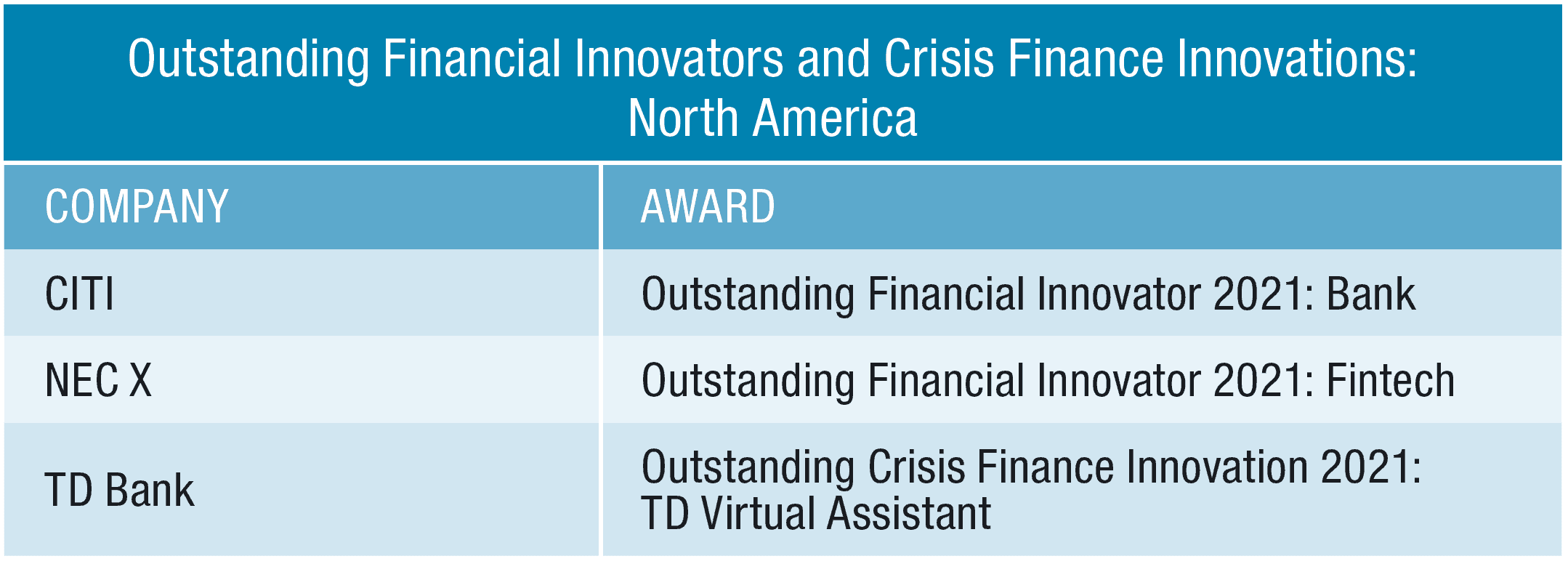From their home offices, these North American banks adapted and met their clients’ needs.

Many companies surprised themselves with just how quickly they could shift to a remote working model during the pandemic. For Citi, this year’s Outstanding Financial Innovator 2021 among North America banks, years of investment in its mobile and digital banking channels prepared it for this exact situation.
“Our investment over the last 10 years enabled us to facilitate the accelerated digitization of customer interactions seamlessly, whether for content, analytics, execution, confirmation or settlement,” says David O’Byrne, global product head of foreign exchange (FX) platforms and distribution at Citi. “Most of our clients had workable solutions in place within a few months—some within weeks. In each case, we were able to offer our clients tremendous flexibility through a set of rich digital channels suited to meet their needs.”
O’Byrne says strategic investment in infrastructure and cloud technologies allowed the bank to innovate more quickly to meet clients’ needs during the pandemic. With more customers executing a greater proportion of their FX wallets electronically in a work-from-home environment, the bank’s mobile trading solution, Citi Velocity Mobile, proved vital, he adds.
Although Citi launched its mobile trading application in 2013, it witnessed a more than 270% increase in mobile transactions at the start of the pandemic last March. Citi staff realized early on that they needed to bring the user experience on the bank’s mobile trading application as close as possible to what FX traders were used to on their desktops.
Gesture-based navigation (swiping left and right) for speed and ease of use; streamlined execution times for a trader’s favorite strategies; the ability to execute trades across a wider range of asset classes, including precious metals; and increased ease of monitoring orders on mobile devices were just some of Citi’s additions to make its mobile trading application even better, according to O’Byrne. “Innovating is about having a relentless focus on the user experience,” he says.
Toronto-Dominion Bank (TD Bank) took a slightly different approach from Citi’s. Instead of a typical mobile-platform release, it responded to an overwhelming increase in Covid-related customer queries at its contact centers during the pandemic by launching a virtual assistant in just three weeks. Working closely with existing technology partner Kasisto, a provider of chatbots using artificial intelligence (AI), TD Bank leveraged its set of pretrained intents and self-serve capabilities to accelerate development timelines and deliver a workable solution, according to bank officials. The virtual assistant was able to answer common customer queries and free up human agents to focus on more value-added tasks.
In its first week of operation, the virtual assistant logged more than 135,000 customer interactions. That number has since climbed to more than 1.7 million, according to TD Bank. The more customers use the virtual assistant, the more it learns, which has helped the bank better understand customers’ needs and intentions. For example, a customer querying card limits using the virtual assistant automatically brings up information on debit or business card limits. With the number of customer calls now handled by the virtual assistant instead of contact center staff, the bank accelerated its digital self-serve customer strategy by two years.
Innovation rarely occurs in a vacuum, even in Silicon Valley, where NEC X—wholly owned by Japanese IT and electronics company NEC—combined its AI and machine-learning accelerator processor with software vendor OppLane’s Cognitive Computing Engine. The result was ID-Redact, a data-privacy management solution that helps make banks’ compliance with an increasing number of federal and state data-governance laws easier.
Historically, this task would have required a sizable number of things; but the NEC X and OppLane solution uses AI algorithms to redact personally identifiable information across a company’s data ecosystem to ensure that it meets data privacy and compliance measures. According to Robbert Emery, director of technology marketing and business development at NEC X, ID-Redact processes data three times faster than existing solutions and with more than 98% accuracy.




